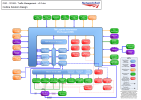Hi, I have a question, I am a signaller in a traditional main line mechanical box (Marches Line). The old way of mechanical signalling seems to work just fine in essance with not much in the way of electronics (in most cases) to go wrong. So why then do we have to upgrade to ROC's controlling miles and miles of railway and hundreds of trains from one location which if something goes wrong it can effect many other parts where as on mechanical if a siganl fails.....it should'nt really effect any other signals on a big way ect? Is it just a case of progression for the sake of progression or a cost saving in terms of less signallers with their wages and boxes with the electricity and water costs ect?
It's really a mix of things. The available technology being a big part of it. To see what I mean, look at the actual progression in places:
The first signalling was completely operated by people, no technology involved. A 'policeman' controlled the train. Often time interval working was used.
Next, simple mechanical signals were used, still operated by a person next to it.
Eventually cabins were provided. This changed into signal boxes. Mechanical interlocking was developed to reduce human error.
As layouts and junctions became more complex, the simple signal boxes were replaced by much larger ones, the benefit was the larger mechanical interlocking that could be accommodated.
But mechanical signalling has limits of how far away a signal can be, and how far a point can be from the signal box. Electrical signalling equipment could extend the area that a mechanical interlocking could control. Hence the larger signal boxes took control from the smaller "nearby" boxes.
This reduction in the number of signallers also resulting in a cost saving to the railway.
lower staff costs, electric points and colour light signals were also (once the capital costs had been repaid) cheaper to run in terms of reduced maintenance costs.
It was then realised that the locking could be done with relays. Hence some large boxes were built with miniature levers that only operated electrical contacts. They had colour light signals and electric points. These could replace both multiple large mechanical signal boxes, and/or a number of smaller boxes.
As relay interlocking developed and as the cost of this technology fell, power signal boxes that used panels (such as the entrance-exit NX type mentioned above) were developed. The interlocking for these is normally called route relay interlocking (RRI). This was a game changer. One PSB could replace hundreds of traditional signal boxes, hundreds of route miles could be controlled. Further, automatic colour light track circuit block sections only required a signaller to monitor them. A PSB could have hundreds of automatic sections covering many miles of route.
But RRI systems are rather power hungry. And they need lots of multicore cables. This all costs money. So alternative technology was investigated. In the U.K. British Rail developed SSI (Solid State Interlocking) that uses microcomputer chips.
In addition, as well as the interlocking being computer based, they also developed control systems called IECC (Integrated Electronic Control Centre). These are computer displays (VDUs) and trackballs that replaced traditional panels. Now called workstations.
These had the advantage that nearly all the (expensive copper) line side long distant multicore cables could be replaced with less expensive single two wire data link cables. Plus, the interlocking cubicles took up much less space (smaller buildings), less power, and, being computer based means even more automation, for no extra money.
Being solid state, they were meant to be more reliable than relay based interlocking. However, it's not as simple as that. Because when a computer based system fails, a whole module fails, so if a module controls two signals, both will fail.
However, the savings in labour costs of signallers is not significantly different between large and complex entrance-exit NX type panels connected to RRI and computer based signalling centres or ROCs.
And the increasing cost of resignalling, or relocking (as it is sometimes known if the new system is keeping the existing signal positions/spacing), means that the savings from slightly lower wage costs are insignificant compared to the capital cost.
The other thing that was driving the programme of large ROCs was the 'political' bigger is better thinking. A very large control room that covers thousands of route miles is more impressive than a line with a bunch of "traditional" PSBs and mechanical signal boxes.
Until of course, the control room has to be evacuated due to a fire alarm going off... Or a system fails taking out a large amount of the signalling.
Also in terms of safety, with a box every so many miles the trains are continuosly under watch wheres in a ROC or indeed a Panal Box there is no way of seeing something wrong and stopping it before it gets to late <snip>
Yes. Hot Axle Box Detectors (HABD) systems and other equipment helps with some of this. But yes, there are far less human eyes watching the passing trains.
and also there is the cybercrime side of it.....if somebody was to hack in (not impossable) surely they could cause havoc across the country wheres as you simply cannot cause as much chaos as you cant hack a mechanical system?
All the vital systems used by Network Rail signalling systems use fail safe methods of communication. Further, nearly all use Network Rail cables or transmission systems. Only a small number use third party links (normally a "private wire" dedicated link provided by BT). So for someone to 'hack' in, they have to physically get access to the cable or equipment. And then they would need enough knowledge of the system. Not impossible, but the risk is extremely small. And where the communication is over a fibre optic cable, well, it's then highly improbable.
Theft of power cable, or vandals just cutting random cables to see if they are copper is a far bigger problem.


